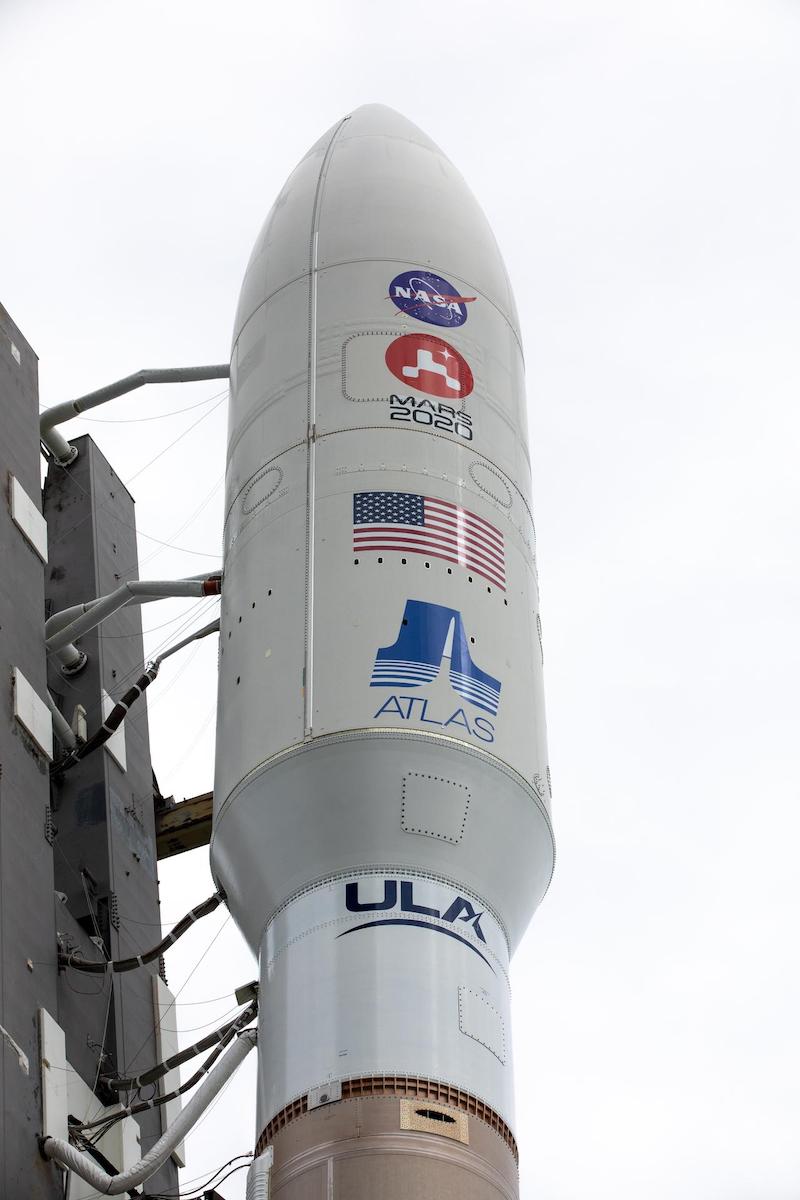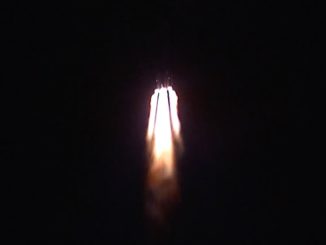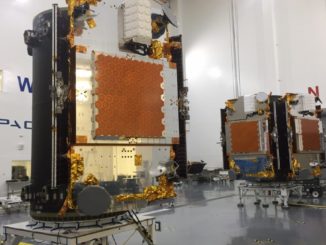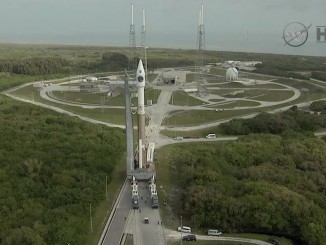
NASA’s Perseverance rover, set for liftoff Thursday on a journey to Mars, posed some unusual challenges for launch crews working with the robot’s plutonium-fueled power generator, but United Launch Alliance’s Atlas 5 rocket is uniquely suited for the job, the company’s CEO says.
The 197-foot-tall (60-meter) Atlas 5 rocket rolled out to pad 41 Tuesday morning at Cape Canaveral Air Force Station, moving into position for blastoff Thursday during a two-hour window opening at 7:50 a.m. EDT (1150 GMT).
Four strap-on solid rocket boosters clustered around the base of the Atlas 5 will give it an extra burst of speed in the first minute-and-a-half of the flight. The boosters, made by Aerojet Rocketdyne, will combine with the Atlas 5’s Russian-built RD-180 main engine to provide some 2.3 million pounds of thrust to get the rocket off the ground.
A single RL10 engine on the Atlas 5’s Centaur upper stage will deliver the Mars 2020 spacecraft on a trajectory away from Earth with a relative velocity of 24,785 mph, or about 11 kilometers per second. That’s fast enough to break free of Earth’s gravitational grasp.
The Mars 2020 spacecraft weighs about 9,000 pounds, or 4.1 metric tons, on top of the Atlas 5 rocket. The entire vehicle at launch will weigh around 1.17 million pounds, or 531 metric tons.
“This rocket is going to leap off the pad with this relatively tiny payload, so do not blink when they say ignition,” said Tory Bruno, president and CEO of United Launch Alliance, the 50-50 joint venture between Boeing and Lockheed Martin that builds Atlas 5 rockets.
Bruno said that the Atlas 5 rocket, set for its 85th flight since debuting in 2002, is healthy and ready for the start of Thursday morning’s countdown.
“Atlas is go, Centaur is go, and we are literally chomping at the bit to take this nuclear-powered dune buggy out to Mars,” Bruno said.
The Atlas 5 will exceed the speed of sound just 35 seconds after firing away from Cape Canaveral, heading southeast from the Florida Space Coast over the Atlantic Ocean. After jettisoning the four strap-on boosters at T+plus 1 minute, 49 seconds, the Atlas 5’s kerosene-burning RD-180 engine will continue firing to power the rocket into space.
At T+plus 3 minutes, 27 seconds, the Atlas 5 will release its payload shroud that shielded the Mars 2020 spacecraft during the first few minutes of flight through the thick lower layers of the atmosphere. The RD-180 main engine will fire until T+plus 4 minutes, 22 seconds, when the Atlas 5 will be flying at 13,470 mph (21,680 kilometers per hour) some 309 miles (497 kilometers) downrange from Cape Canaveral.
The first burn by the Centaur stage’s RL10C-1 engine, which produces 22,900 pounds of thrust, will place the Mars 2020 spacecraft into a low-altitude parking orbit around Earth around 11-and-a-half minutes after liftoff. After coasting over the Atlantic Ocean and South Africa, the Centaur stage will ignite its RL10 engine a second time for an eight-minute maneuver to propel the Mars 2020 spacecraft to escape velocity.
After shutting down the engine nearly 53 minutes into the mission, the Centaur stage will deploy the Mars 2020 spacecraft at T+plus 57 minutes, 32 seconds.
The $2.7 billion mission is due to reach Mars and land Feb. 18, 2021.
The Mars-bound rover carries a Multi-Mission Radioisotope Thermoelectric Generator containing 10.6 pounds (4.8 kilograms) of plutonium dioxide fuel in a ceramic form. The generator will produce electricity to power the Perseverance rover throughout its mission.
The radioactive fuel is encased in multiple layers of protective blast shielding to ensure it will not rupture in the event of a launch failure.
“It’s a very safe device, but still it’s close to 11 pounds of plutonium, so there are significant handling restrictions associated with it,” Bruno said in an interview Wednesday with Spaceflight Now. It’s a thermoelectric device, and its always giving off a couple of kilowatts of waste heat, so there are special handling considerations involved with that.”
Developed by the U.S. Department of Energy, the MMRTG works by converting heat from the natural radioactive decay of plutonium-238 — a special non-weapons grade isotope of plutonium — into electricity. The generator contains 10.6 pounds (4.8 kilograms) of plutonium dioxide fuel.
The device produces about 110 watts of power at the start of Perseverance’s mission, roughly equivalent to the power draw of a light bulb. The MMRTG’s power efficiency declines by a few percent per year.
The MMRTG will charge two lithium-ion batteries on the Perseverance rover. The batteries will power the robot during times of peak power usage, when NASA says power demand can reach 900 watts during science operations on Mars.
Nearly 95 percent of the energy produced by the MMRTG will be in the form of excess heat. That will help keep the Perseverance rover’s internal electronics warm in the cold temperatures at the Martian surface.
But before the launch, the heat produced by the nuclear power generator poses challenges for cooling systems inside the Atlas 5’s assembly building. That’s why teams waited to install the MMRTG on the rover last week, just days before the Atlas 5 rolled out of the Vertical Integration Facility to pad 41 for final countdown preps.
The payload fairing surrounding the Mars 2020 spacecraft atop the Atlas 5 rocket has a large access door, allowing engineers enough room to fit the nuclear device — which measures a bit larger than a 5-gallon bucket — through the shroud and mount it onto the rover.
“We had configured our Vertical Integration Facility with a portable customized clean room, so that we could bring the rocket there, integrate the spacecraft, button it up, and then right at the end … bring in the MMRTG through the VIF, coming in through that giant hatchway, and then install it with the clean room running,” Bruno said.
SpaceX’s Falcon Heavy rocket also has enough power to send the Mars 2020 spacecraft toward the Red Planet. But SpaceX, for now, does not have the ability to install payloads on the Falcon Heavy in a vertical configuration. SpaceX plans to build a mobile gantry at pad 39A to support that capability in the coming years.
NASA awarded ULA the launch contract for the Mars 2020 spacecraft in 2016, before the Falcon Heavy’s first test flight, meaning the Atlas 5 was the only launcher certified for the mission.
Bruno said the mobile clean room set up inside ULA’s vertical rocket hangar allowed ground crews to mount the MMRTG ont he spacecraft in a pristine environment to meet stringent “planetary protection” protocols.
“Planetary protection makes us want to be very very careful that we don’t contaminate the lander with biological (material) because we’re off looking for life on Mars, and if you bring life with you, that kind of messes up that experiment,” Bruno said.
“The other part of it of course is Atlas’s reliability,” Bruno told Spaceflight Now. “We have to make sure that this multi-billion dollar mission gets off to Mars. We also want to make sure that nothing happens to the MMRTG in the course of that mission, even though they are designed to withstand a rocket failure, and even re-entry. That has happened in the past. Again, it’s a very safe device, but you have to be and want to be extra, extra careful.”
The MMRTG is the latest in a line of nuclear power sources and heaters used on more than 30 U.S. space missions since 1961. The Atlas 5 has launched two of those probes on previous missions — NASA’s New Horizons mission to Pluto and the Curiosity Mars rover.
NASA’s next nuclear-powered space probe will be Dragonfly, an airborne rotorcraft that will launch in 2026 to Saturn’s moon Titan. NASA has not yet selected rocket for that mission.

There’s one other change to the Atlas 5 rocket for missions with nuclear-powered payloads, according to Omar Baez, NASA’s launch director for the Mars 2020 mission. The modificiation is in the pyrotechnic system that would be activated to destroy the Atlas 5 if it deviates from its planned course and threatens populated areas.
Such an event is highly unlikely, and the Atlas 5 has successfully reached orbit on all 84 of its missions to date.
“If you did have some kind of accident, that’s to prevent the MMRTG from being a danger to the public,” Baez said. “So we try to be very precise in destroying, for example the Centaur (upper stage), in a way that the MMRTG is not in harms way, where it could harm the public.”
Baez said the same type of ordnance system was used on the Atlas 5 rocket that launched the Curiosity Mars rover in 2011. The Perseverance rover is similar in design to Curiosity, but carries a different set of scientific instruments.
“We’re humbled to be trusted with such an imp mission,” Bruno said. “We’re obviously proud of having flown all of the U.S. missions to Mars.
“This one is special because it’s more sophisticated, and it’s a more complex mission, and in a way it’s potentially more significant than all the ones that preceded it,” Bruno said. “The instrumentation that it has to pave the way for future human exploration, to experiment with making oxygen, and of course, they’re putting it on Jezero Crater, which is this ancient river delta. We know that on Earth those kinds of geological formations have sedimentary deposits that have been able to preserve evidence for microbial life for billions of years.
“This is really the best chance of finding evidence of ancient Martian life,” he continued. “The other element of it that’s interesting is it’s really connected to future missions in a way that other missions haven’t been, with the caching of samples. It’s going to collect samples of the Martian surface and put them in different places, and then there will be future missions planned that will come and get them.
“So it’s really, really exciting. It has the potential to open up a whole new avenue of exploration. Oh my gosh, if it finds evidence of ancient life, it will change our perception or our place in the universe.”
Email the author.
Follow Stephen Clark on Twitter: @StephenClark1.



